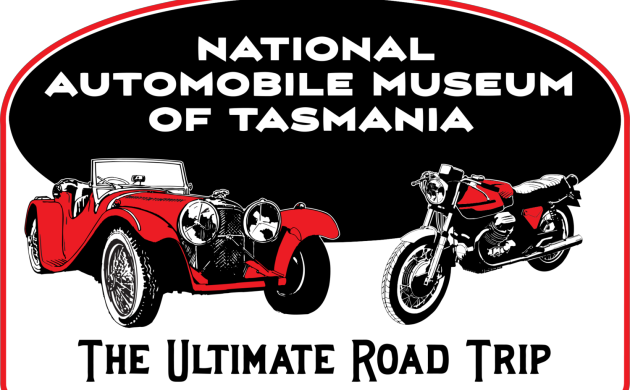
The world is full of hidden treasures in the form of private collections and museums dedicated to a broad cross-section of motoring enthusiasts. I recently had the pleasure to visit one such establishment, The National Automobile Museum of Tasmania. Readers from the Northern Hemisphere may know little about Tasmania, but it is an island state below mainland Australia. Launceston is the state’s largest northern city, and that is where you will find the Museum. Whether you are an Australian reader or one from a foreign country considering a holiday Down Under, this box is worth ticking. Run by four staff and a dedicated group of volunteers, it features an eclectic mix of classics that present superbly. Display vehicles owned by private collectors rotate regularly through the site. Therefore, every visit reveals something new and exciting. The Museum also features theme displays, spotlighting cars from a specific country, era, or genre. You can find more information on the NAMT website or regularly updated on its Facebook page.

One of the classics featured in the Museum’s “Hall of Muscle” is this 1967 Ford XR Falcon GT. It is considered the father of the Australian muscle car. Ford took its existing Falcon Sedan, which thousands of buyers bought as sensible family transport, and added a touch of spice. Its engine bay houses the A-Code version of the 289ci V8, producing 225hp and 305 ft/lbs of torque. Buyers could select from a four-speed manual or three-speed automatic transmission, with the company upgrading the suspension and brakes to improve the car’s handling and stopping power. Almost all were finished in Russet Bronze, with eight finished in Gallaher Silver. In later years, a few came to light, finished in Sultan Maroon, Polar White, Avis White, and Ivy Green. Ford introduced the GT as a racing homologation special, allowing it to compete in that year’s Bathurst 500. The company’s faith was rewarded with a one/two finish.
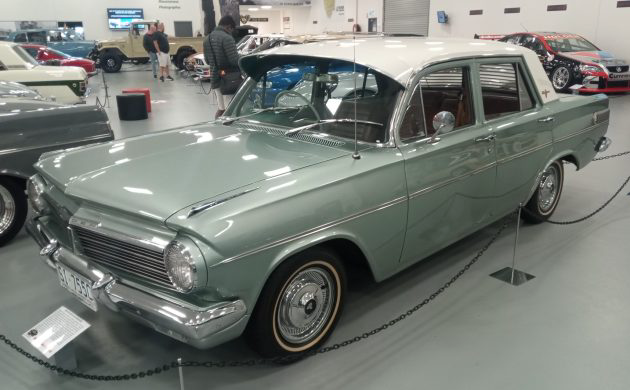
Australia’s post-war car industry comprised imports or locally assembled foreign models. Holden released the first genuine Australian car in 1948, with its subsequent models featuring evolutionary versions of the company’s tried-and-true mechanical components. However, 1963 brought the most significant change when Holden introduced an entirely new engine range. They are referred to colloquially as the “red motors” courtesy of the color they were painted. These powerplants saw the light of day in the Holden EH, which remains one of the most desirable and highly sought-after models. This EH is the range-topping Premier version powered by the largest “red” with a capacity of 179ci. Shifting duties fall to a three-speed Hydramatic transmission. The Premier was the most luxurious model in the EH range, with bucket seats, leather trim, a center console with an integrated heater, and a folding rear seat armrest. This car lifts its desirability because its original owner ordered it with a selection of factory accessories, including a sunvisor, mesh headlight protectors, a rear louver, and exterior mirrors.

The staple of Ford Australia’s model range from 1960 was the Falcon. Based heavily upon the North American variant, it required significant reengineering to cope with Australia’s harsh conditions. The company released the Falcon XA in 1972, featuring styling that owed nothing to its American cousins. It underwent a cosmetic update in 1973 with the release of the XB model, which remained in production until 1976. As with its predecessors, buyers could order a GT version with a V8 under the hood. The Windsor that had served so faithfully back in the days of the XR was a distant memory because buyers now received the 351ci Cleveland V8. Once again, they could choose between manual and automatic transmissions. This XB Falcon GT rolled off the line in 1975, and many purists consider it the last of the “true” GTs. The driver had 300hp at their disposal, allowing this Falcon to cover the ¼-mile in 14.9 seconds. That figure isn’t bad for a car that comfortably seats five adults. Australia’s version of emission regulations was poised to strike, and the badge would disappear with the following model.
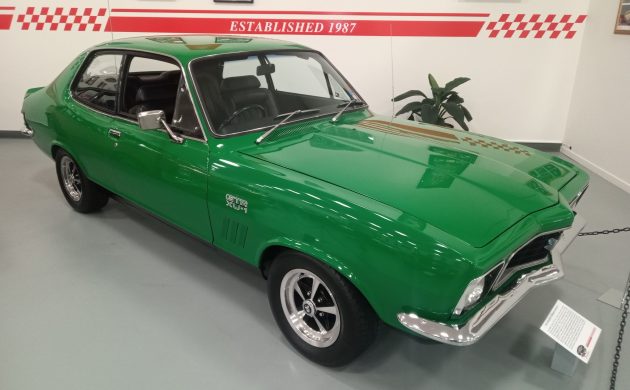
While Ford pursued the V8 path with its Bathurst homologation specials during the late 1960s and early 1970s, Holden took a different approach with its Torana models. These cars are significantly smaller and lighter than the competition, and power comes from a six with some useful upgrades. This is a 1972 LJ Torana GTR XU-1, the most potent version available that year. Its 202ci powerplant inhales deeply through triple CD-175 Zenith-Stromberg carburetors. These motors received a special camshaft grind, sending 190hp to the rear wheels via a four-speed close-ratio manual transmission. The XU-1 gave away power and outright speed to the Ford Falcon GTHO, but it proved a genuine giant killer. It carried Peter Brock to victory in the 1972 Bathurst 500. It looked set to repeat the feat the following year before a catastrophic miscalculation saw Brock’s car lose precious minutes being pushed to the pits after running out of fuel!
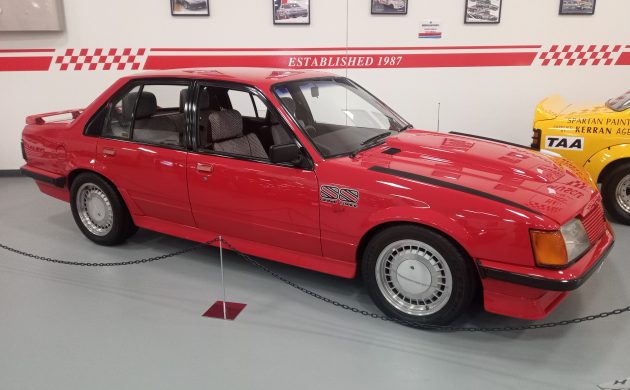
The late Peter Brock’s name is indelibly linked to the Holden brand, and the cars bearing his name are more desirable now than before his tragic death in 2006. Brock operated as part of the company’s factory team and as a privateer but became the owner of the Holden Dealer Team in 1980. Scraping together racing funds was accomplished via some long-term sponsors and by an ingenious arrangement with dealerships and Holden. He formed a company called HDT Special Vehicles with factory support. Cars from Holden would be removed from the production line and shipped to Brock’s workshop. He would upgrade the engine, suspension, tires, and other components to extract significant performance gains. The cars would be delivered to select dealerships, who would then sell them to recoup their costs and turn a profit. The catch was that those dealers had to commit sponsorship dollars to the race team. It sounds complex, but it worked extraordinarily well. Brock secured a racing budget, and select showrooms featured cars that would draw a crowd and boost sales. However, there was more to it than meets the eye because the “Brock” Commodores were used to homologate race parts. This 1982 VH Commodore Group 3 SS is a perfect example of the breed. Its drivetrain configuration is no more potent than its predecessor. The “big ticket” change was HDT’s decision to fit fewer luxury options. That allowed them to homologate this model with a lower racing weight, increasing its competitive edge over the opposing manufacturers.

Holden wasn’t standing still during the early 1970s as Ford released its new Falcon range. It unveiled its full-size Kingswood range in 1971, including the two-door hardtop Monaro. This was the sporting variant, and buyers could order the range-topping GTS powered by Chevrolet’s 350ci small-block V8. This Monaro rolled off the line in 1974 and is totally original and unrestored. It has remained part of the same family since Day One, but its history makes it extraordinary. Tasmania’s state capital is Hobart, straddling both sides of the Derwent Bridge. The Tasman Bridge is a multi-span concrete structure with evenly-spaced pylons that links the two shores. The two closest to the bridge’s center have a broader opening to allow shipping traffic to pass safely. Late on the night of January 5th, 1975, a bulk ore carrier named the Lake Illawarra was approaching the bridge but was off course. It missed the navigation channel, striking several pylons. Part of the bridge collapsed onto the ship, which sank with the loss of seven crew. Unfortunately, four cars plunged from the bridge, with another five losing their lives. A gentleman named Frank Manley was driving this Monaro when the lights in front of him suddenly disappeared. He immediately hit the brakes, and the car slid to a halt. Incredibly, it was teetering on the edge of the bridge, only inches from disaster. As you can see in this article on the ABC website, calls don’t come much closer than this!
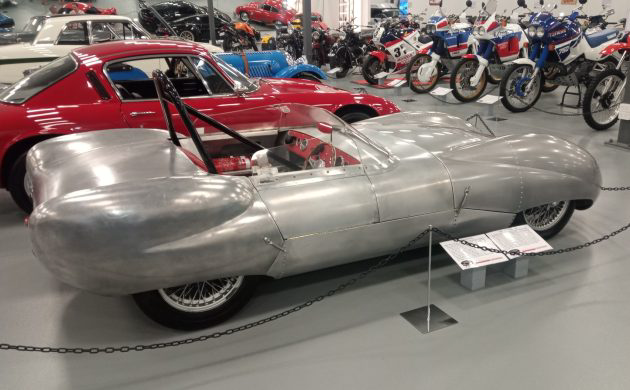
The NAMT doesn’t focus exclusively on Australian models; it takes a global approach with its exhibits. Lotus produced the 11 from 1956 to 1958, powering the new model with an 1,100cc Coventry Climax motor. This 1956 Lotus 11 is a perfect example and is another car that comes with a fascinating backstory. Its original owner purchased it as an incomplete vehicle, planning to finish the build in his garage. Tragically, he passed away only days after taking delivery, and the car spent years gathering dust. His widow sold the car to another enthusiast, and its curse struck a second time when he also passed away. The car changed hands again, and the new owner made some progress before tragically losing his eyesight in a motor vehicle accident! It eventually came to the attention of its current owner, who completed the build in 2016. There can’t be many project builds where the process has occupied six decades.

The “Best of British” theme continues with this 1956 Austin-Healey. However, this is no ordinary car; it is the incredibly desirable 100/M version. The company performed many engine upgrades to components like the carburetors and camshaft and fitted a cold air box. While a “normal” 100 would produce 90hp, this car’s driver has 110hp under their right foot. The transformation was profound, slashing a second from the ¼-mile ET and raising the top speed to 118mph.
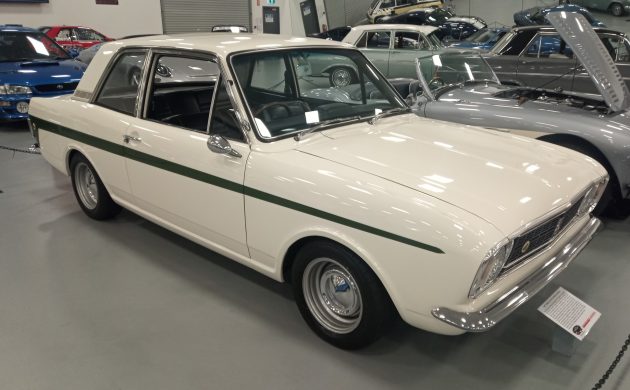
What would a motor museum be without a Lotus Cortina on display? This is a Mk II version, produced in 1967. The Mk II marked a significant change in build strategy, with Ford keeping the whole process in-house to improve build quality. The 1,557cc twin-cam four sent 115hp and 106 ft/lbs of torque to the rear wheels via a four-speed manual transmission. This Cortina presents well, and has a successful competition history. Drivers who took it to the max include Spencer Martin, Dick Johnson, Dennis Brown, Brian Michelmore, and Steven Johnson.
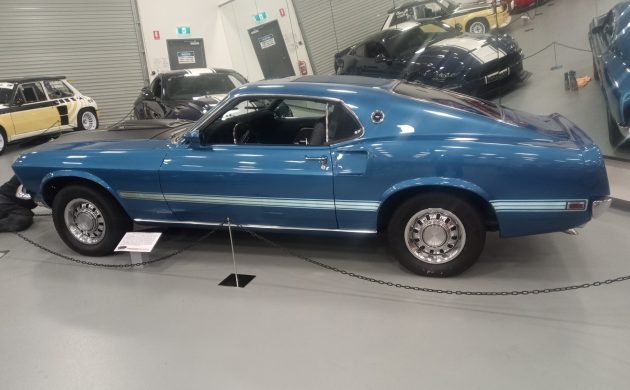
I haven’t forgotten our North American readers, who will undoubtedly appreciate this 1969 Mustang Mach 1. Finished in Acapulco Blue, its engine bay houses an M-Code 351ci V8. It sends 290hp and 385 ft/lbs of torque to the road via a three-speed automatic transmission. It presents beautifully and doesn’t spend its entire life as a display vehicle. Almost every car at the NAMT is mechanically healthy and roadworthy. Owners often “borrow” their cars for an outing or show, returning them so crowds can admire and enjoy them.
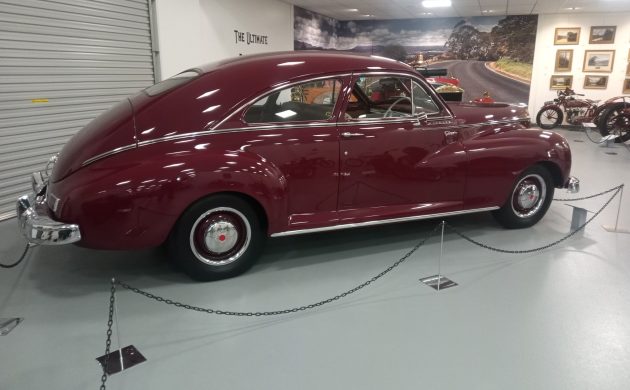
America’s post-war economy was strong. Buyers hadn’t seen a new passenger car since 1942, but Packard jumped into the fray as the first company to release a new model. However, the term “new model” isn’t strictly accurate, as most companies ramped up production using mildly reworked versions of their pre-war offerings. This 1947 Packard Clipper 8 Coupe is one such car, and our US readers may find it interesting. It is a little-known fact that the company enjoyed a presence Down Under, and this Clipper is a locally assembled car. Look through the front window, and you’ll spot the steering wheel on the right since that is the Australian standard.

Cadillac was once considered the benchmark in the luxury car market, but its beginnings were as humble as most. This car is a 1906 Model K Runabout. It features a single-cylinder engine producing 10hp. A two-speed planetary transmission sends the power to the rear wheels, giving a top speed of around 25mph. I mentioned earlier that many displayed vehicles are roadworthy, and this Cadillac is no exception. Its current owner completed a journey from Perth, in Western Australia, to Sydney, in New South Wales, in 2012. That might not sound overwhelming to those from foreign shores, but it covers 4,200 kilometers (2,600 miles)!
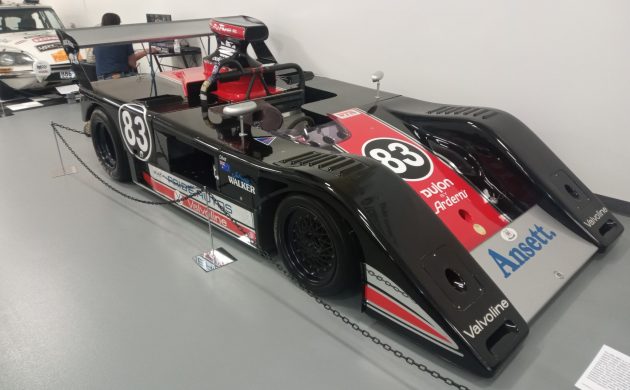
Australia has a strong motorsport heritage, and I have long considered this 1969 Elfin ME5 one of the country’s most attractive sports cars. Elfin was formed by racer Garrie Cooper, concentrating most of its effort on vehicles for open-wheel formulae. However, Cooper willingly ventured into the Australian Sports Car Championship with several models. Only one ME5 was built, powered by the potent Bartz-modified 5.0-liter Chevrolet V8. It competed successfully for many years and landed at the NAMT after its recent restoration.
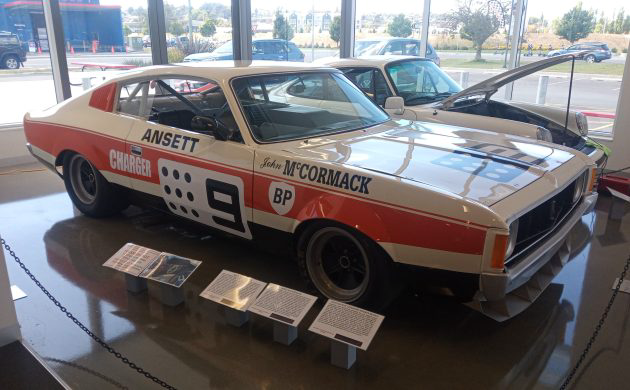
The Elfin ME5 may be wild, but it pales next to this 1974 Chrysler Valiant Charger. The Sports Sedan racing category was emerging during the early 1970s, and circuit promoters were offering large prize purses to lure big names to the category. Cars could be modified significantly but had to retain a large proportion of the original sheet metal. Legendary driver John McCormack scrutinized the Rule Book, discovering a loophole that hadn’t been exploited. The engine could be moved from its original location within certain parameters. Engines were also free, meaning motors from other manufacturers were allowed. McCormack transformed a relatively humble base-model Charger into a formidable weapon. Its original six-cylinder engine made way for a 5.0-liter Repco V8. The decision to move the engine back in the chassis for better weight distribution made this car stand out. It wasn’t a small move, with the V8 nestled under the driver’s elbow. The results justified the effort because this car scored twenty-seven wins from forty-two race starts in 1974.
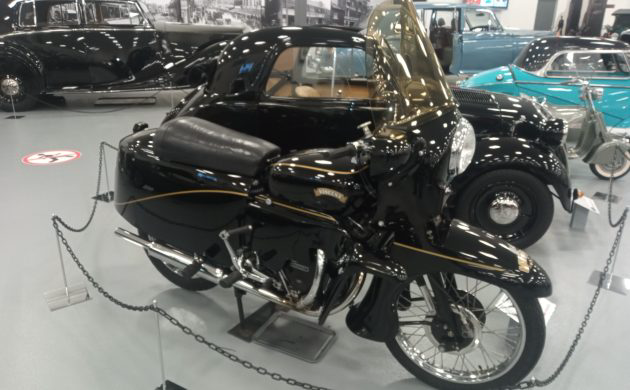
If you prefer your classics with two wheels, the NAMT has you covered. It holds an extensive collection of motorcycles, covering every decade from the early Twentieth Century. One of my favorites is this 1955 Vincent Black Knight. Its “faired” sides must have looked futuristic when the machine was new, and the Black Knight has aged remarkably well. Vincent produced the Black Knight for a mere two years, but it was a potent beast. Its 998cc V-twin engine sends 45hp to the road via a four-speed manual transmission. The Vincent was a fast machine, but the fiberglass fairings improved aerodynamic efficiency to make it even faster.

If the Vincent is a bit much for you, this 1949 Lambretta B125 might be more your style. Its owner has attached a 1948 Durapid sidecar to increase its versatility. The Lambretta features a 123cc engine and a three-speed transmission. The top speed should be around 40mph, although the sidecar will undoubtedly impact performance. The sidecar could be the star of the show. Durapid produced these in Rome, sand-casting the three-piece shell in magnesium. That makes them exceptionally light and ideally suited to machines with modest power outputs. I immediately thought of our Scotty Gibertson when I saw this machine. He loves small motorcycles, and this one is tiny. I’m not tall, but you can see how easy it was to shoot an image from above this machine.

The National Automobile Museum of Tasmania is a treasure and is well worth visiting. There is an excellent assortment of vehicles on display, interactive exhibits, and a vast memorabilia shop. I spent hours there and could easily have spent longer. The cars I have featured barely scratch the surface, and with a rolling roster of vehicles, there is something new to see at every visit. There is so much to see and appreciate, so if you are considering a journey to that neck of the woods, do yourself a favor and drop in for a look.


Great article Adam!
I’ll bet there will be lots of questions about our unique cars.
Sadly I have owned some of these cars, wish I still had them.
Yes, I agree, this is a great article!
Sadly I missed this place when in Tasmania just over four years ago!
However, coming across the Bentley Club outing was a good compensation, as were the great scallop pies that I tried in Richmond, and Hobart, and…. (Oh! dear)
It looks really great. Sadly, I doubt I’ll ever make that trip.
I wonder if anyone knows of any car museums in Canada where they have a lot of the vehicles unique to that great country.
When I was in Canada friends took me to Reynolds Museum in Wetaskiwin (I think thats how it is spelled), Alberta. They had a huge collection from cars to aircraft. They were restoring a 1900’s victoria with lots of brass. I came from Sask.
It came from Southern Sask.
Great write up. What a wonderful collection of vehicles I’ll likely never see in person. What interesting to me is the overall influence of US and European style on Australian design. It’s good to be treated to vehicles from around the world. Even better are the comments and expectations shared by one another. Thank you for allowing us this privilege.
This is Bill Burke’s Phase III. He was sent over from Dearborn to manage Ford Australia and to instigate the Falcon GT/GTHO.
Without him, it would never gave happened.
He had a 428 but into his personal Phase III at the factory. The only one, well sort of.
The car still exists today, being driven as it was meant to be.
There is rumours that a US Tudor Falcon was imported for Bill, converted to right hand drive and also fitted with a 428. I’m trying to prove/disprove that rumour.
I’m passionate about Aussie muscle (I did own a Brock Commodore) but passionate about Ford’s
Here’s a link to Bill’s Phase III
https://www.drive.com.au/news/ford-falcon-gtho-phase-i-truth-behind-bill-bourke-special/
Articles on Ho down the Hume (hyw) or 140mph down the Hume
http://www.fomoco.com.au/HO-DTH.html
https://www.streetmachine.com.au/features/the-true-story-of-ho-down-the-hume.
I was 6yo when my dad bought a phase III new, but I can remember the needle going past 140mph..
Interesting titbits, my dad kept snapping engine mounts (guess that explains why I’m a hoon, lol).
Ford factory fix was to attach a chain to the block and chassis, that stopped the torque from snapping the engine mounts (as told to me when I was old enough to understand).
He also kept blowing Tyers, in the end ford said you choose the Tyers, we will pay for it, just this once.
Went there a few years back by accident.
I was at a boring family function at a hotel/ restaurant across the road and went outside for some fresh air. I came back 2 hours later and, apart from a raised eyebrow from my wife, I got away with it. The motorcycle collection is fabulous as are the well researched plaques on many of the vehicles.
I agree with Aussie Dave, this is a great article Adam!!
The Aussies had a great performance race withe the Super Car series. mad Nascar look like a suday school picnic
Unfortunately, Morley, Australia’s interesting sedan/production car races are no more! Instead we get the boring V8 Supercars
The Aussies had a great performance race withe the Super Car series. mad Nascar look like a suday school picnic
Thanks, Adam. I’m in agreement with earlier comments … a great article. I live in country Victoria and have been to Tassie many times. Sadly I have not known of this museum. Now it’s a must for me to get there. Any traveller to Victoria has the opportunity to visit similar museums. Unfortunately we are about to lose the iconic Holden museum in Echuca due to its owners retiring.
Time to buy a ticket to Tasmania!
Hello
Sorry to break the news to you that the Austin-Healey shown in the article is not a 100M. It is a 100 BN2 chassis BN2L/232753 that was originally sold new in the US and imported to Australia. I was involved in its sale of the car to the past owner who sadly died a few years back, leaving the car to his son.
There appears to be a Messerschmitt parked behind the Lambretta (visible also in the Vincent photo).
I remember seeing one of those Messerschmitts parked in Kent Street, Sydney in the mid 1960s.
Can you imagine a parking space in Kent Street, Sydney these days?
What a great coincidence to be reading this article this morning. My wife and I arrived in Tasmania last night and one of our first visits today will be the National Automobile Museum of Tasmania. Can’t wait.
Thanks! Fantastic read!! If I ever have the chance to go to Australia, I would definitely go here!